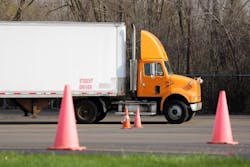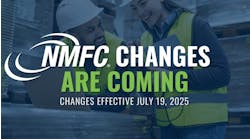This is the second part of FleetOwner’s look at new or potential trucking industry-related regulations of interest in 2022. Read Part 1 here.
The federal government could be spending much of 2022 catching up with some of the top fleets and trucking technologies. A lot of new or pending requirements for the industry, such as automatic emergency braking, and regulations, such as speed limiters, are already employed by successful trucking companies around the country.
The success of these technologies, along with the growing potential of self-driving trucks to move freight, is pushing the government to work these into federal rule-making.
Some of the top carriers continue to lead the way with technology and systems ahead of regulations, David Heller, the Truckload Carriers Association VP of governmental affairs, told FleetOwner. “Many carriers that are operating on the road today have already employed this type of technology and are taking the lead on this ahead of any regulation that comes out.”
Along with technology, a more than 5-year-old proposal to streamline driver training takes effect early in 2022 and the Compliance, Safety, Accountability (CSA) scoring system is worth keeping an eye on. Here’s a look at these trucking regulations and concepts that regulators could address in 2022:
Automated driving
The federal regulatory agenda is sprinkled with proposed rules addressing autonomous driving, road safety, and research. As several robotic trucking companies ramp up testing and target humanless freight transport by mid-decade, the U.S. Department of Transportation (USDOT) is considering amending current rules and looking into new ones to keep advancing technology.
The Federal Motor Carrier Safety Administration (FMCSA) wants to amend some Federal Motor Carrier Safety Regulations (FMCSRs) to recognize the difference between human-operated and automated driving systems (ADS) “to ensure the safe introduction of ADS-equipped commercial motor vehicles (CMVs) onto the nation’s roadways,” according to an advanced notice of proposed rule-making scheduled to be published in June.
Questions remain of liability when autonomous vehicles are involved in traffic crashes or commit other violations, according to Prasad Sharma, a partner with Scopelitis Law Firm. If the human in a self-driving vehicle is not responsible because they are not technically driving, who is? “There are big issues that need to be addressed with some kind of framework and deployment,” he said.
The proposal would change commercial vehicle operations, inspection, repair, and maintenance regulations to “prioritize safety and security, promote innovation, foster a consistent regulatory approach to ADS-equipped CMVs, and recognize the difference between human operators and ADS,” according to USDOT’s fall 2021 federal regulatory agenda filing.
This forward-looking proposal matches what the trucking industry is focused on as autonomy appears inevitable. “It represents the future,” Heller said. “This is what the industry looks like in the long run—not in terms of replacing the professional truck driver because that’s not going to happen. But it’s in terms of getting them the equipment that improves our safety record, that is justified in accident prevention.”
While some freight lanes appear ripe for hub-to-hub automation soon, most industry experts and robotic trucking companies anticipate drivers will still have jobs decades from now.
“This is not going to replace the professional truck driver—this may help redefine their job a little bit better,” Heller said. “I don’t think this is a renewed interest; it’s a continued interest in the industry as a whole. That interest is going to continue to grow. It’s a technology that goes down that road of literally reducing accidents. It’s the same thing when you talk about ADAS—it’s about reducing accidents.”
Automatic Emergency Braking
One advanced driver assistance system (ADAS) technology that is already proving valuable in reducing accidents is automatic emergency braking (AEB), which will become standard on all passenger cars and light trucks in 2022, thanks to an agreement car manufacturers made with the administration of President Barack Obama. While most commercial truck OEMs are employing the technology, the new infrastructure law will require the technology within two years.
“We certainly want to put safety first and actually invest in accident prevention technologies such as AEB,” Heller said. “There is real need for that out there, which is why our carriers are well ahead of any sort of mandate in actually spec’ing that out on their trucks and pieces of equipment.”
Speed limiters
After the Obama administration proposed requiring speed limiters on large trucks, the Trump administration shelved the plan. Before Biden took office, House Democrats proposed including a similar provision in a failed 2020 infrastructure bill. With the Senate taking the lead on the Bipartisan Infrastructure Law that Biden signed in November, this and other trucking regulations (such as increasing minimum insurance liability) didn’t reemerge in 2021.
Heller said the topic is on TCA’s radar. “It’s one of those things that would go a long way to help reduce the No. 1 cause of accidents on the road today,” he said. “Speed continues to be very prevalent in terms of accident causation.”
Heller noted that most fleets are already using limiters set between 58 and 70 mph “for the purpose of safety and probably fuel savings. Tools such as these show how the industry is ahead of the curve when it comes to regulations.”
Entry-Level Driver Training
After years of delay, FMCSA’s Entry Level Driver Training (ELDT) regulations go into effect Feb. 7. The new rule standardizes professional driver training of entry-level drivers, regardless of age.
Heller said the goal is for potential holders of commercial driver's licenses (CDL) to “be trained to a model which demonstrates that each driver is able to safely operate a commercial motor vehicle. In a sense, standardizing a training curriculum would improve our industry’s ability to train drivers who enter the industry. At a time when some schools were very loose on their training curriculum, while others were producing safe students, this rule raises the bar to training that had not previously been there.”
Once the ELDT system is in place, the FMCSA Training Provider Registry will file records of CDL applicants who completed the new training and certification processes. Any applicant who obtains a new CDL or commercial learner’s permit (CLP) before Feb. 7, will not be subject to ELDT requirements, with some exceptions.
“This is a rule that was developed though the Entry Level Driver Training Advisory Committee that effectively developed the rules based upon the needs of the industry, through a negotiated rule-making put forth in 2015,” Heller explained.
CSA changes
The Trump administration tried to put its stamp on the Compliance, Safety, Accountability (CSA) scoring system but did not get a rule published before their time in Washington ran out. FMCSA worked with the National Academy of Sciences to look at some statistical challenges within that system and recommended the Item Response Theory in 2017 as an alternative to the CSA Safety Measurement System scoring method.
CSA, which has existed more than a decade, surviving three presidential administrations, could continue to be refined. “The problem with the Item Response Theory is getting people to explain it,” Heller said.
While CSA “has its issues,” Heller said that TCA and its member carriers believe that “determination of safety fitness is something that a responsible carrier should never be afraid of. We take safety very, very seriously.”







